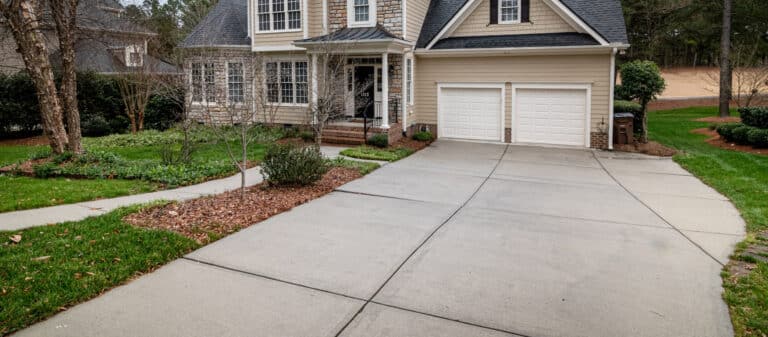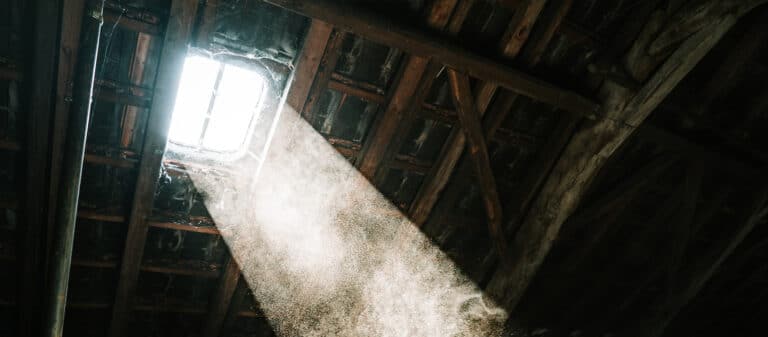It wasn’t until 1965 that home insulation became standard on new builds across Pennsylvania.
However, it’s rare to find a home around the Wilkes-Barre / Scranton areas anymore without insulation of some sort in the attic.
The problem homeowners may face is not the thought of having no insulation but of having to remove old insulation.
In addition to natural settling and degradation, one thing could threaten the longevity and safety of your insulation more than anything else: moisture.
More specifically, this moisture can cause mold growth, eating away at the insulating material and triggering allergy-like symptoms in anyone inhaling the spores.
Ironically, poor insulation installation is often one of the leading causes of mold growth. However, several issues in your home can lead to mold growth in insulation if you are not careful.
This guide will help you diagnose those causes and provide a plan to replace or repair mold-infested insulation.
Common Causes of Mold Growth on Insulation
Mold thrives in environments with moisture, organic material, and limited airflow, typically where we install insulation. More specifically, crawl spaces, wall cavities, basements, and attics are common places where mold and insulation can be found, which suffer from poor airflow.
There are several things that can expose your insulation to moisture, including:
- Leaks in the roof or walls
- Poor ventilation
- High humidity levels
- Condensation buildup
- Flooding or water damage
However, the most common cause of mold growth on insulation typically occurs from poor ventilation as a result of poor insulation installation. This is why we highly caution against DIY insulation, even on easier projects, such as walk-in attics. For example, unintentionally blocking eaves and ridge vents can trap moisture inside your attic, leading to high humidity and mold growth.
One important factor to also consider is the type of insulation you’re dealing with and how susceptible it is to mold.
Spray foam is naturally moisture resistant, offering a better defense against mold and degradation than fiberglass, which is the most common form of insulation that encounters mold.
Signs of Mold on Insulation
Worse yet, mold can hide inside your insulation for long periods of time without being visible. This is even more true if you have insulation contained behind a closed wall or ceiling.
Be sure to look for these signs of mold on your insulation and schedule an inspection at the first sign:
- Visible black, green, or white spots on insulation material
- Musty or earthy odors
- Increased allergy symptoms, such as sneezing or respiratory issues
- Deterioration of insulation fibers
Can Moldy Insulation Be Cleaned?
We get it; you may be reluctant to replace a whole roll of insulation if it gets moldy, especially if it was installed fairly recently.
However, in almost any circumstance, insulation with exposed mold will need to be replaced.
The only exception may be a (mostly) non-porous surface like closed-cell spray foam, which can be cleaned with bleach. Any porous surface, such as fiberglass and cellulose, cannot be cleaned and will need to be removed.
How Dangerous Is Mold on Insulation?
Not all species of mold are necessarily harmful, right? Unfortunately, any mold on your insulation can trigger respiratory and a whole host of additional issues.
The most common issues associated with mold exposure include:
- Respiratory issues – Mold spores can trigger asthma attacks and allergic reactions.
- Weakened immune system – Prolonged exposure may lead to chronic illnesses.
- Structural damage – Mold can degrade building materials, leading to costly repairs.
In most cases, if mold is present as a result of moisture exposure, it’s most likely black mold, which is considered one of the most harmful species of mold.
Steps to Take if You Find Mold on Insulation
If you discover mold on your insulation, follow these steps to handle it safely and protect yourself:
1. Assess the Extent of the Problem
Determine how widespread the mold growth is. If it’s a small, localized area, you can handle the removal yourself. However, professional remediation is recommended if the infestation covers a large area (greater than 10 square feet).
2. Wear Personal Protective Equipment (PPE)
Direct contact with mold can cause numerous health issues, including itchiness, burning, and rashes. Before handling or inhaling moldy insulation, be sure always to wear protective gear, such as an N95 respirator, safety gloves, goggles, and long-sleeved clothing.
3. Remove the Affected Insulation
First, plastic sheeting should be used to seal off the contaminated area and prevent mold spores from spreading. Then, carefully remove the mold-infested insulation and place it in sealed plastic bags.
You’ll need to contact your local authorities to find a proper hazardous waste disposal location for the affected insulation.
4. Clean and Treat the Area
After insulation removal, you’ll need to clean and disinfect any surfaces that have come in contact with the mold. Most often, a bleach solution will be the most powerful, especially for dealing with black mold spores.
5. Improve Ventilation and Address Moisture Issues
Finally, you can take steps to prevent future mold from returning by addressing issues that led to its initial growth. This includes improving ventilation, repairing any leaks in your home, and properly installing new insulation to allow for optimal airflow.
While minor mold issues can be handled with DIY methods, professional remediation is necessary in many cases, especially when there is extensive water damage or mold growth present.
To ensure proper installation of all future insulation, be sure to contact a professional insulation installer for the best results. They will be able to advise you on the best insulation materials for your project and offer ways to improve ventilation and prevent any risk of future mold growth.
FAQs
How can I tell if my insulation has mold?
Look for visible black, green, or white spots, musty odors, or signs of deterioration in the insulation fibers. Increased allergy symptoms, such as sneezing or respiratory issues, may also indicate hidden mold.
What causes mold to grow on insulation?
Mold thrives in moist, poorly ventilated areas. Common causes include roof or wall leaks, condensation, high humidity, poor ventilation, and improper insulation installation.
Can I clean mold off of insulation, or do I need to replace it?
In most cases, moldy insulation must be replaced, especially if it’s made from porous materials like fiberglass or cellulose. Closed-cell spray foam, which is less porous, may be cleaned if the mold is minimal.











